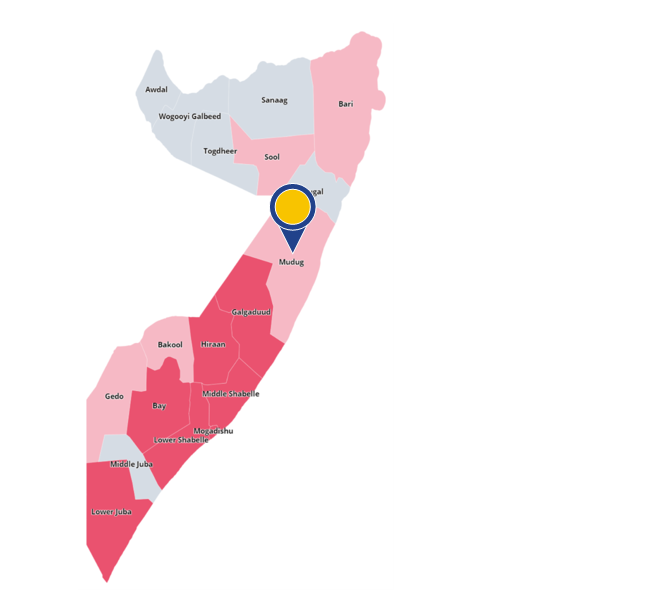COMMON ANALYSIS
Last update: August 2023
The situation in Mudug should be seen in light of the situation in the neighbouring region of Galgaduud and Nugal (in Puntland).
Main COI references: [Security 2023, 2.5.2., pp. 146-152; COI Update 2023, 1.2., p. 9; 1.3.4., pp. 16-19; Security 2021, 2.5.2, pp. 115-116; Actors, 7.5, pp. 96-97]

General information
Mudug region is divided between Galmudug and Puntland; the latter controls the northern half of Mudug. The town of Galkacyo, located in the western part of Mudug is also split up between Galmudug (south section) and Puntland (north section).
Mudug consists of five districts and Gaalkacyo is the regional capital.
In the south, Mudug is mainly inhabited by the Saad, a Habr Gedir (Hawiye) sub-clan, which is also the dominant clan in the area. Northern Mudug is mainly inhabited by the Omar Mohamoud, a Majerteen (Darood) sub-clan, which is the dominant clan in the area. Cross-border clan groups are also present in the area.
In 2021, UNOCHA estimated the population in Mudug region at 1 244 027 inhabitants.
Background and actors involved in armed confrontations
Southern Mudug
The main conflict dynamics in the reference period included the fighting between Al-Shabaab and Somali security forces, including local pro-government forces and Danab and Darwish forces.
In mid-January 2023, the strategic Harardhere town, an Al-Shabaab’s stronghold, was captured by anti Al-Shabaab’s forces.
As of 30 November 2022, Al-Shabaab reportedly controlled the southeastern most part of Xararheere district, and a narrow section in the south of Hobyo district, including the town of Xaradheere. Control over the western and northwest part of Hobyo town was reportedly mixed or unclear, as well as the area in the eastern part of the capital city of Gaalkacyo, along the border of Galmudug with Puntland.
Clan rivalries were also reported, which were reportedly triggered by disputes over water resources and fuelled by Al-Shabaab.
Northern Mudug (Puntland)
As of 30 November 2022, control over a narrow strip in the eastern part of the regional capital city of Gaalkacyo, at the border of Galmudug with Puntland, was reportedly of mixed or unclear control between the forces of Al-Shabaab and the government.
Inter-clan violence was a major source of conflict. As reported in July 2021, disputes between the Hawiye/Habr Gedir versus Darood/Majeerteen and Darood/Laylkase clans persisted.
Nature of violence and examples of incidents
Illustrative security incidents include, for example the opening of fire along the road connecting Gaalkacyo town to Dagaari area in the Gaalkacyo district by the Somali Danab forces in September 2022. Reportedly, civilians were killed and injured.
On 20 July 2022, a car carrying civilians was hit by a landmine explosion in Galdogob district, resulting in the death of the driver and the injury of passengers.
In March 2022, reportedly Al-Shabaab militants set fire to houses in Adale district, displacing their residents. A case of conflict-related rape in Dagaari village was verified by UNSOM.
In March 2022, seven herdsmen and their livestock were reportedly kidnapped by Al-Shabaab militants in Hobyo district, in the Barag Isse area.
In July and August 2021, two landmine explosions were recorded in the area surrounding Baadweyne, in Hobyo district. The first one occurred on 9 July 2021, when a landmine explosion destroyed a public transport vehicle on the outskirts of Baadweyne village, causing the death of at least two civilians and the injury of many others. On 10 August 2021 the second landmine explosion was recorded in Amara, when a rickshaw hit a landmine, reportedly killing at least seven people, and injuring many others, including women and children.
Incidents: data
ACLED recorded 90 security incidents (an average of 1.2 security incidents per week) in Mudug region between 1 July 2021 and 30 November 2022. Out of those incidents, 43 were coded as ‘battles’, 19 as ‘explosions/remote violence’ and 28 as ‘violence against civilians’. In the period from 1 December 2022 to 14 April 2023, 39 security incidents were recorded in Mudug representing an average of 2 security incidents per week.
Geographical scope
Security incidents occurred in all five districts of Mudug with the largest number being recorded in Galkacyo (34 incidents), followed by Hobyo district (26 incidents).
Fatalities among civilians and non-civilians
In the 17 months between July 2021 and November 2022, ACLED recorded a total of 358 fatalities in the region. In the 4.5 months between December 2022 and mid-April 2023, ACLED recorded a total of 528 fatalities in the region. Compared to the figures for the population in the region as from 2021, this represents approximately 71 fatalities per 100 000 inhabitants for the whole reference period.
Displacement
Between July 2021 and November 2022, 16 513 individuals were newly displaced from Mudug, according to PRMN. Of them, 76 % were displaced within the region, while the remaining 3 900 individuals were displaced to Bari, Benadir, and Galgaduug.
Between December 2022 and March 2023, 81 529 individuals were newly displaced from Mudug, according to PRMN, a region particularly affected by counterinsurgency operations since January 2023.
Further impact on civilians
Seven humanitarian access incidents were documented by UNOCHA during the reference period.
Looking at the indicators, it can be concluded that indiscriminate violence is taking place in the region of Mudug, however not at a high level. Accordingly, a higher level of individual elements is required in order to show substantial grounds for believing that a civilian, returned to the territory, would face a real risk of serious harm within the meaning of Article 15(c) QD.
